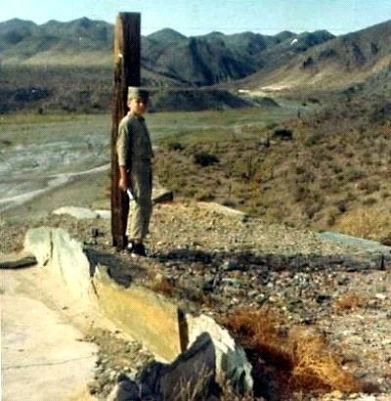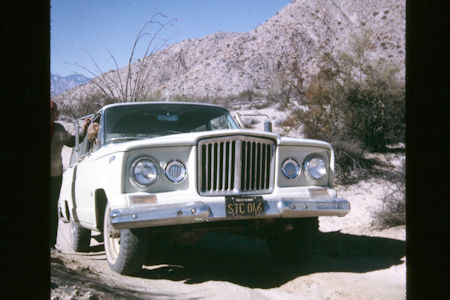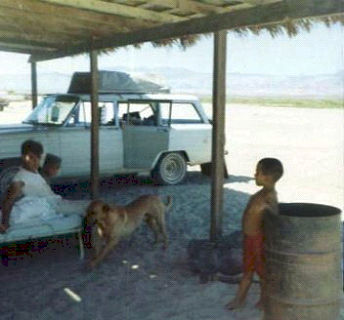 |  |

By David Kier
Fifty-three years ago, in the summer of 1967, my parents and I took our Jeep Wagoneer to L.A. Bay going through San Felipe, Gonzaga Bay, and Calamajué Canyon. Here is the trip story from what I remember:
I was almost ten years old, (my 'wonder years') and my parents and I had been traveling and four-wheeling in Baja California for two years. All of us were totally entranced by the rugged and beautiful peninsula. The previous summer (1966) we made the great overland journey from Tijuana to Cabo San Lucas (that took two weeks, with 800 miles on dirt roads). We didn't detour to L.A. Bay then, saving it for next year!
Our route to Bahía de los Ángeles was to go south from Mexicali and San Felipe. Even though the 'toughest' road in Baja was this way (Puertecitos to Gonzaga Bay), that was better than going through the dust bowl at Laguna Chapala, on the main trans-peninsular road. We experienced that place the previous year. The talcum powder fine silty dust that one had to plow through, before the dry lakebed, was the worst part of the 1000+ mile trip!
In 1967, San Felipe's main street was dirt, right where Highway 5 came to an end. We topped the fuel tanks, stocked up on bolillos at the bakery, and then headed south. The road was graded dirt to Puertecitos and stayed inland from the coast passing through the sulfur mine valley.
Puertecitos was then a small resort settlement with a cafe, motel rooms, airstrip, and some wonderful albeit stinky hot springs at the water's edge. It was here, in 1965, patrons informed my dad that this was the 'end of the road'. My dad (that year) made it to Gonzaga Bay, anyway...towing a tent trailer! A determined dentist and a Jeep Wagoneer are a combination NOT to be underestimated! The 'Gonzaga Grades' (as we called them) south of Puertecitos were a great challenge, even with low-range, four wheel drive. Today's paved road and graded dirt detours some people think are bad, is like a super-highway compared to the original road over the volcanic ridges. Parts of it can be seen from the present road on opposing canyon walls.
Leaving Puertecitos we engaged 4WD Low Range and crawled the Jeep over each of the six extremely steep volcanic staircases ('Gonzaga Grades' my folks called them) that ended at El Huerfanito. A small café built near the shore, across from the Little Orphan island (El Huerfanito). Many children appeared and my parents had brought hard candies (dulces) for them. Those were much appreciated!
The road alternated between flat terrain and small grades as we continued on. The next campo was 'Okie Landing', a sport fishing camp with some palapas and an icehouse, built into a cave. Finally, Bahía San Luis Gonzaga came into view. The first time we came here, was in 1965 and we camped near Alfonsina's.

From Gonzaga Bay we headed south through the boulders of Las Arrastras and water filled Calamajué Canyon to El Crucero on the trans peninsular main road. The main roads of Baja back then were just two deep parallel ruts in sandy or rocky terrain. You could almost let go of the steering wheel and the ruts would steer the Jeep for you! In a few miles we turned off the main Baja road and headed for L.A. Bay. A few miles later, we arrived at Desengaño where we stopped to examine the several adobe buildings from this 1930's gold mine.
More miles down the road, just like today, the first view of the 'Bay of Angels' was breathtaking! The town of L.A. Bay was only about 100 people who mostly worked for Señor Diaz or fished for turtles. Casa Diaz was THE place, the ONLY place for tourists, in 1967! Casa Diaz was operated by 'Papa' (Antero) and Cruz Diaz. Now, the problem was Mrs. Diaz did not appreciate being called 'Mama' by anyone but her own children. However, where there is a 'papa' then there must be a 'mama', right? This issue was documented in many publications of the time. In more recent years, I heard Cruz relented and accepted the name 'Mama Diaz' with a smile!
Cruz was a famous for her turtle steaks, as she ran the kitchen at Casa Diaz. Pilots would make great detours in flight plans should an opportunity for a meal prepared by Señora Diaz arise! Most customers at Casa Diaz were pilots and their passengers. The closest paved road was just north of Colonet, 280 miles away or San Felipe, about 200 miles north. Jeep and motorcycle clients were rare. The L.A. Bay airstrip's south end was at Casa Diaz, a collection of cinder block cabins. There, pilots would taxi their planes up to and park in front of their room. Much like automobiles at a motor lodge.
Legendary Baja pilot, Francisco Muñoz, operated a small airline called 'Baja Air Service' that flew from Tijuana to L.A. Bay, Mulegé, and Puerto Vallarta... an airline ahead of its time. My dad even flew with Muñoz over Baja in the co-pilot's seat, read below…
Casa Diaz may have been the first time anyone showered in solar heated water from tanks on the roof! Another innovation in Baja. The only trick was to shower in the afternoon, because without a day's sunlight it would be less than ideal water temperature! In the summer, it was way too warm at night to sleep in the rooms. So, every room had cots on the outside for sleeping under the stars... that was great! About ten o'clock, Papa would shut off his generator (the town's only source of electricity), after a couple of warning brown outs, to give you time to light lanterns. Then, a billion stars would grab your attention. No finer sleep at any hotel could be had than that system at Casa Diaz...under the stars!
Papa Diaz had a big yacht anchored offshore. He took groups fishing on it. The yacht was called the 'San Augustine'. If there was an emergency, Papa would go to his yacht and use the HAM radio onboard. The U.S. Coast Guard could fly a helicopter down, if needed to rescue an injured person.

The kids at L.A. Bay had an interesting toy. Kind of a Baja version of a cap gun. The toy was the invention of Dick Daggett Jr., who was the town mechanic. Dick's father jumped ship in the 1890's, hid in a cave until the ship left and stayed in Baja. More on the Daggett’s in another article... Anyway, using discarded spark plugs, a large nail, and a string, these 'cap gun toys' were made. The ceramic was removed, and the hollowed-out spark plug core was where a wooden match was inserted and twisted, leaving the sulfurous tip behind. The nail was then inserted. A loop of string attached the nail to the spark plug, then holding the loop one would slam the head of the nail against a wall. The point of the nail ignited the match head, and BANG!!! It was quite effective. We considered marketing the product!
One other family was brave enough to drive into L.A. Bay that summer. It was the Anderson family of Valley Center. Their bodies and vehicle showed clearly, they came south from Ensenada as the Laguna Chapala dust was all over them! They were in a Land Rover with two boys a couple years older than my 9+ years of age. I had a Briggs and Stratton powered minibike and the two Anderson boys were very interested in it. They had a room at Casa Diaz at first, but then moved out to the sand point to camp (where the lighthouse is now). My dad drove us out to party with them one day, on the sand point. They were quite surprised that we had ice and my dad could whip up some ice-cold adult drinks!
The Anderson's note in Diaz' logbook read: "We came over in a Land Rover. The road was rough, but the Rover is tough... We whaled our tails!" Some seven years later, I took a world history class in high school. The teacher would mention Baja California, he had a Land Rover... yep, that's right, talk about a small world! I started to describe that trip of '67... it was really shocking how we ended up re-meeting. He specially remembered my dad's icy cocktails! I think I got an ‘A’ in Terry Anderson's world history class! Viva Baja!
Getting there was only HALF the adventure!
My mom was already 'Baja Proven' and wanted to do the driving going home so my dad could fly on with Captain Muñoz to see what that was like. We got to the old mill ruins at the edge of Calamajué Canyon, where we spent the first night on the return. The next day, just a few miles north, we ran out of gas or something stalled us. My mom was not worried, as we were aware of a Baja tour 4WD Carryall and Nissan Patrol support vehicle somewhere behind us. My mom set up our bridge table and prepared slices of ice cold watermelon to serve our rescuers!/p>
Soon, the 4WD 'bus' arrived and out came the passengers (older ladies mostly). Their air conditioning was on the fritz... and it was well over 100°! One of the tour passengers took my mom aside and begged her to take her as a passenger... offering large sums of money, even! I guess this early Baja tour company was less than prepared for the toils of the land. My mom declined preferring the uncomplicated status quo. The watermelon was a hit, we got some gas or whatever was needed, and headed for Alfonsina's. Alfonsina's had a few rooms for rent back in those days, so there we stayed the second night out.

We headed towards Puertecitos the next morning pulling off to look at a water hole, 'Agua de Mezquitito'. The area was thick with quail. Climbing over the grades, we came upon a Mexican supply truck stalled near the summit. We stopped to offer assistance, and the driver quickly placed rocks behind our Jeep's tires, should we roll back to certain death! All along the steep grades between Puertecitos and El Huerfanito were crosses and wrecked cars and trucks in the canyons below. Brake failure, 2WDs losing traction, and simply mis-steering on the narrow trail were the likely cause of those tragedies.
We made it to Puertecitos and rented a room for the night. That was when I first enjoyed the famous sulfur hot springs at the water's edge. Timing is critical to enjoy the pools which are totally covered at high tide and too hot if low tide has kept the sea water away too long. Yes, you will smell like a rotten egg, but your aches and pains of the harsh road will be gone!
Once back home, we all had interesting stories to share, and I had gained some new great memories of Baja in the Golden Years! Thank you, mom and dad, for giving me “Baja Fever!”
About David
David Kier is a veteran Baja traveler, author of 'Baja California - Land Of Missions' and co-author of 'Old Missions of the Californias'. Visit the Old Missions website.